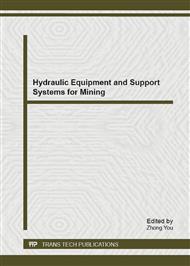p.425
p.431
p.435
p.439
p.443
p.447
p.451
p.455
p.459
Decoupling Control of Secondary Regulation Loading System
Abstract:
The simulation loading system with secondary regulation contains hydraulic coupling and mechanical coupling. This study analyzed the influence on the performance of the system caused by coupling disturbances. Control performance under coupling disturbances with PID control was simulated by MATLAB. With the increasing of the pressure fluctuations, fluctuations of torque control and speed control system all changed. The influence of torque control system is greater than speed control system. When the torque fluctuated, the drive speed appeared large fluctuation error and the error was direct ratio to the torque fluctuation. But the torque system is immune to the speed fluctuation. In order to eliminate the influences, a decoupling controller has been designed. Control performances under the disturbance of hydraulic and mechanical coupling with decoupling controller and without decoupling controller were simulated. The results showed that, when added decoupling components, the system was decoupled, the negative influence of the coupling interferences to the system was reduced or eliminated, the control property was improved.
Info:
Periodical:
Pages:
443-446
Citation:
Online since:
December 2012
Price:
Сopyright:
© 2013 Trans Tech Publications Ltd. All Rights Reserved
Share:
Citation:


